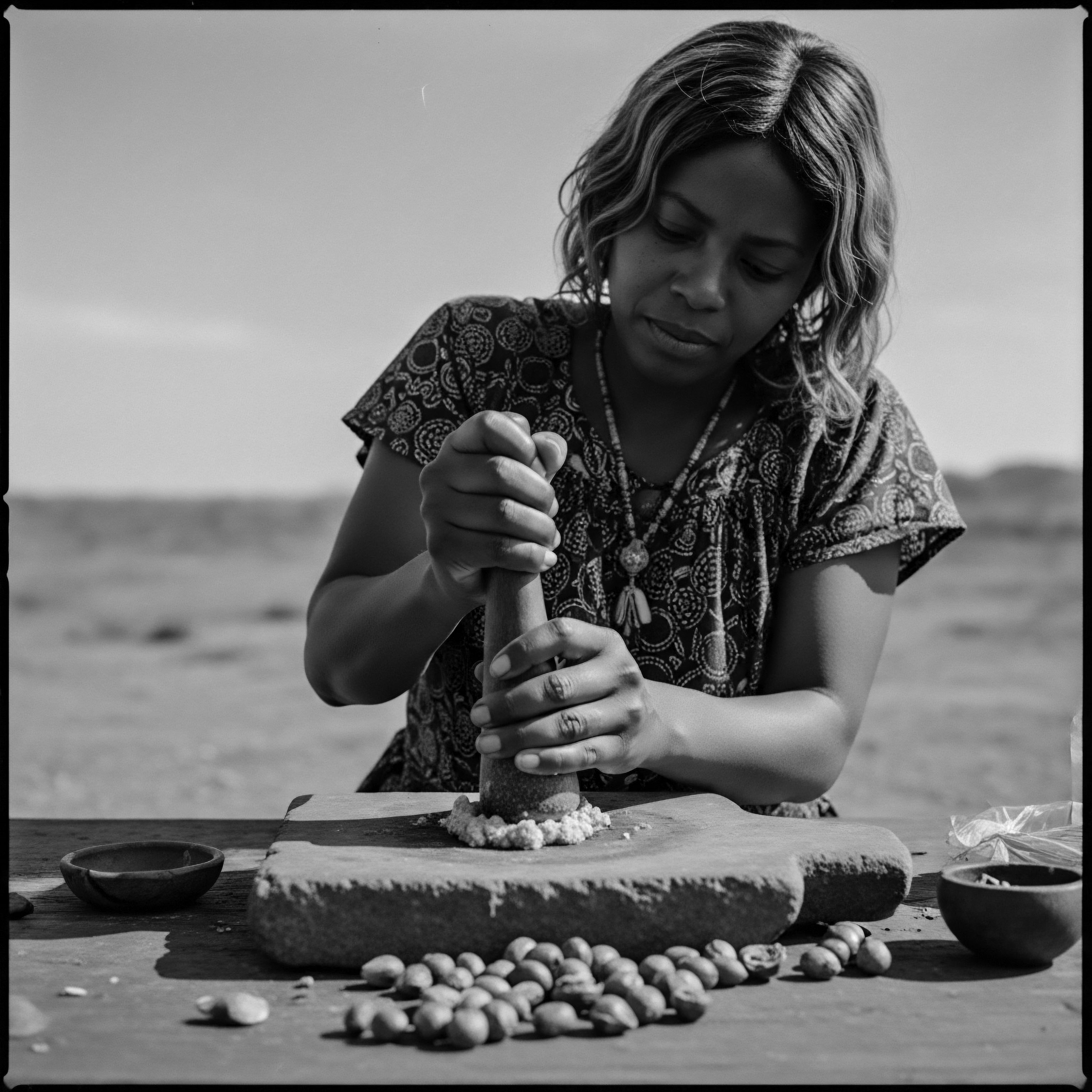
Fundamentals
The concept we call ‘Natural Hair Protections’ is, at its heart, an understanding that textured hair, particularly that of Black and mixed-race lineages, possesses inherent capabilities to withstand external stressors and maintain its vitality. This knowledge is not a recent discovery, but an ancient wisdom, passed through generations, often silently, within the very fibers of communal living. It speaks to the intrinsic strength and resilience gifted to these unique hair patterns, which, when honored and understood, can shield themselves from the rigors of existence. This safeguarding can be both an internal biological predisposition and an external practice, a delicate balance of what the hair naturally possesses and what purposeful care provides.
Consider the elemental biology of textured strands. Their coiled or tightly curled architecture, often described as helixes, provides a natural spring and volume. This distinct structure means that natural oils produced by the scalp, known as sebum, travel slower down the hair shaft compared to straighter textures. Consequently, textured hair often experiences greater natural dryness.
This characteristic, though sometimes seen as a vulnerability in modern contexts, has, through ancestral eyes, been understood as an inherent signal for specific, attentive care. The cuticles, the outermost layer of the hair, also play a vital role in this protective framework. In textured hair, these cuticles may be raised or less uniformly laid, which, while allowing for greater absorption of moisture, also calls for careful handling to prevent damage. Understanding these foundational aspects of textured hair’s biological make-up forms the bedrock of its natural defenses.
Natural Hair Protections signify the intrinsic and cultivated resilience of textured hair, echoing ancient wisdom and biological predispositions.
From the earliest rhythms of communal life, ancestral practices emerged as profound extensions of these intrinsic protections. These were not merely acts of grooming; they were rituals, expressions of community, identity, and profound connection to the land and its bounty. The application of indigenous butters, oils, and clays, often sourced directly from the earth, served as crucial barriers against environmental assault. Imagine the sun-drenched savannas or humid forests; hair, often exposed, required more than just adornment.
It demanded guardianship. These ancient practices were born from acute observation and deep respect for the natural world.
- Shea Butter ❉ Revered for its rich emollient properties, it was traditionally applied to hair and scalp to seal in moisture and provide a physical barrier against dryness and sun exposure.
- Baobab Oil ❉ Harvested from the majestic baobab tree, this oil was prized for its conditioning abilities, offering nourishment and assisting in maintaining elasticity in the hair shaft.
- Red Clay (e.g. Rhassoul Clay) ❉ Used for gentle cleansing and detoxification, these clays also provided minerals that could fortify the hair and scalp, contributing to the hair’s natural defenses.
These methods, passed down through the gentle tutelage of mothers and elders, represent the original understanding of ‘Natural Hair Protections.’ They recognized the hair as a living extension of the self, susceptible to the elements but also capable of profound resilience when supported by intentional, culturally informed care. The protective styles, too, were not just aesthetic choices. Cornrows, Bantu knots, and various braiding patterns served to consolidate fragile strands, minimizing tangling and breakage, thereby preserving length and strength. This deliberate minimization of manipulation was, and remains, a cornerstone of hair health in textured hair communities, a quiet testament to the enduring wisdom of those who came before us.
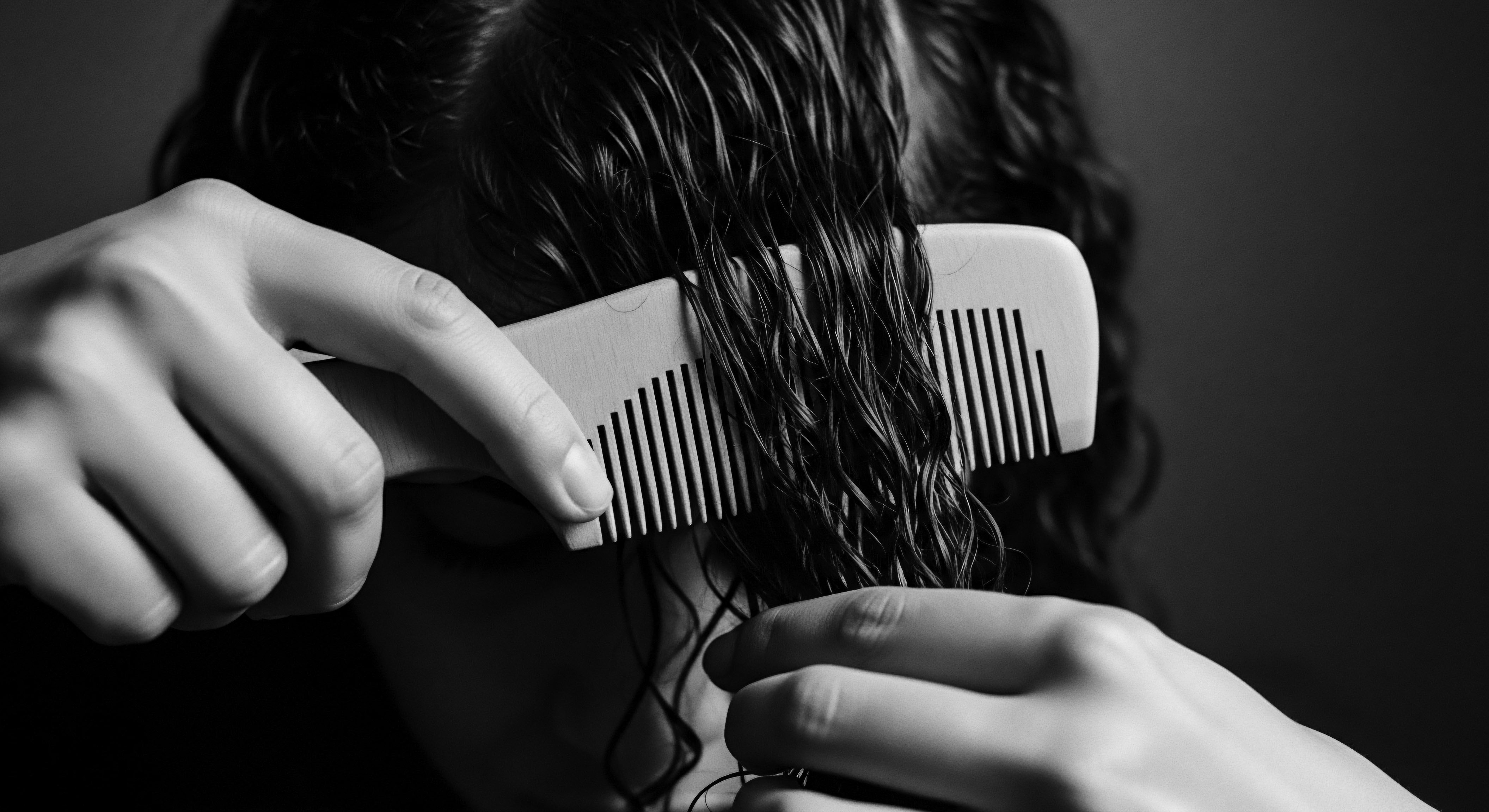
Intermediate
Moving beyond the foundational elements, an intermediate apprehension of ‘Natural Hair Protections’ deepens into the living traditions of care and community, exploring how ancestral practices have shaped the ongoing dialogue between our heritage and our hair’s well-being. This perspective reveals that the safeguards extended to textured hair are not static concepts but rather a continuous thread, woven through history, adapting yet retaining their core wisdom. The significance of these protections extends beyond physical preservation; it encompasses the emotional, spiritual, and communal sustenance derived from hair care rituals.
Historically, the meaning of hair in Black and mixed-race communities transcended mere aesthetics. It was a language, a symbol of lineage, social standing, spiritual belief, and often, an emblem of resistance. The deliberate practices surrounding ‘Natural Hair Protections’ thus became acts of profound self-preservation and cultural affirmation. During periods of immense upheaval, such as the transatlantic slave trade, the continuity of certain hair care traditions became a subversive act, a way to maintain dignity and identity in the face of brutal dehumanization.
Enslaved Africans, stripped of nearly everything, often painstakingly recreated protective styles and utilized whatever natural ingredients they could find – palm oil, roots, herbs – to maintain their hair. This perseverance was a silent declaration of selfhood, a powerful manifestation of Natural Hair Protections in its most profound sense.
Consider the profound role of communal hair care sessions, often held within the intimate spaces of the home or community gathering. These were not simply opportunities to tend to physical strands; they were moments of storytelling, of sharing wisdom, of intergenerational bonding. The act of braiding or oiling another’s hair built connections, fortified familial ties, and transmitted knowledge about proper care techniques, passed from hand to hand, generation to generation. This relational aspect of care served as a powerful, unspoken layer of Natural Hair Protections, shielding not only the hair itself but also the spirit of the individual and the collective.
The historical continuity of hair care practices in Black and mixed-race communities highlights the enduring resilience and cultural significance of Natural Hair Protections.
The resilience of textured hair, often subjected to societal pressures and beauty standards that did not affirm its natural form, also finds its protective shield in this continuum of care. The notion that textured hair required ‘taming’ or ‘straightening’ for professional or social acceptance presented a significant challenge. Yet, within communities, there persisted an intrinsic understanding of the hair’s natural inclinations and its need for gentler, more aligned methods.
This internal validation, often passed down through elders who remembered practices predating or resisting colonial influences, served as an internal compass, guiding individuals back to methods that truly honored their hair’s inherent nature. This internal resistance to external pressures is a form of protection itself, a psychological shield against harmful narratives.
The very act of maintaining styles like cornrows or twists, for instance, became a silent form of activism, particularly during eras of overt discrimination. These styles, which are functionally protective, also served as visible affirmations of Black identity and heritage, thereby guarding against the psychological damage of assimilationist pressures. Opoku (2018) meticulously details how, across West African cultures, intricate braiding patterns were not merely aesthetic; they were functional designs that protected the hair from the elements, reduced breakage, and facilitated growth, allowing individuals to maintain healthy hair through daily activities and lengthy journeys. This functional aspect of protection continued through the diaspora, becoming a core strategy for maintaining hair health and identity under diverse conditions.
| Ingredient Kukui Nut Oil |
| Traditional Use Used in Hawaii for moisturizing skin and hair, especially for sun protection. |
| Protective Mechanism Rich in fatty acids, forms a lightweight barrier against environmental damage and moisture loss. |
| Ingredient Chebe Powder |
| Traditional Use Chadian tradition for strengthening hair and retaining length. |
| Protective Mechanism A blend of natural herbs that coats the hair shaft, reducing breakage and strengthening strands over time. |
| Ingredient Fenugreek Seeds |
| Traditional Use Used in Indian and African hair care for conditioning and growth. |
| Protective Mechanism Contain proteins and nicotinic acid, nourishing follicles and reducing hair fall, thereby preserving density. |
| Ingredient These ancestral ingredients demonstrate a deep, inherited understanding of how natural compounds can shield hair from environmental stressors and maintain its vitality. |
Thus, the intermediate understanding of Natural Hair Protections recognizes a dynamic interplay ❉ the biology of textured hair, the historical legacy of resistance and affirmation, and the communal practices that have sustained and adapted through centuries. It is an exploration of how the tender thread of care, interwoven with collective memory, continues to preserve and celebrate the unbound helix of textured hair, ensuring its health and its story endure.
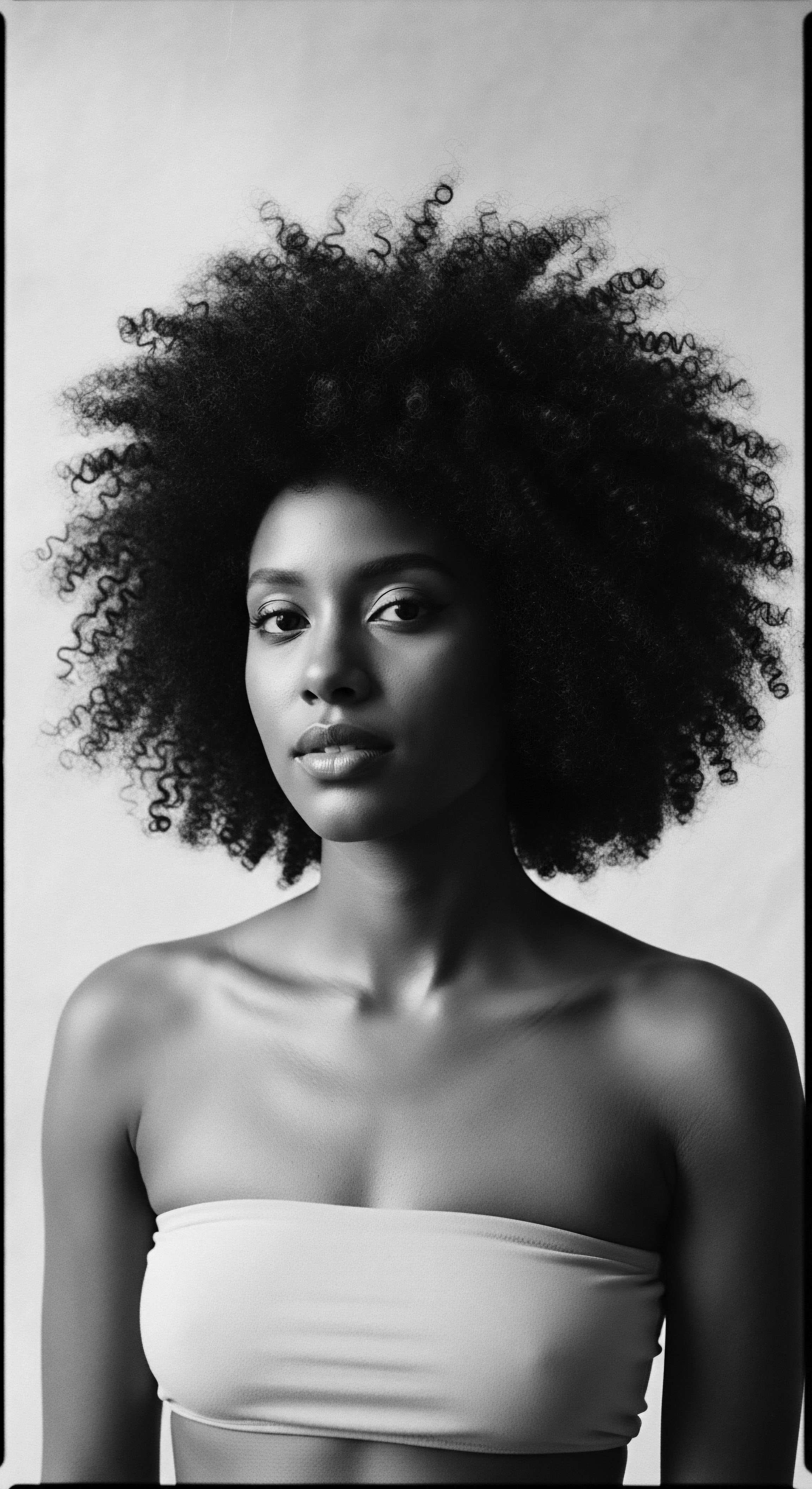
Academic
The academic delineation of ‘Natural Hair Protections’ postulates a complex interplay between inherent biological mechanisms, historically evolved care paradigms, and the socio-cultural constructs that either amplify or diminish the resilience of textured hair, particularly within Black and mixed-race populations. This definition extends beyond mere physical safeguarding, encompassing the preservation of hair’s integrity against both environmental exigencies and the insidious pressures of systemic bias. It posits that the protective capacity of textured hair is not solely a physiological attribute, but a co-created phenomenon, shaped by ancestral ingenuity, material resourcefulness, and collective cultural valuation. The profound meaning of this concept, therefore, resides in its multi-scalar manifestations ❉ from the molecular architecture of the hair shaft to the macro-level socio-historical movements that have affirmed its intrinsic worth.
At a micro-anatomical level, the helical structure of textured hair presents a paradox of strength and fragility. While the coiled configuration grants volume and elasticity, it also necessitates more points of bending and torsion along the shaft, rendering it susceptible to mechanical stress and breakage if not adequately managed. The uneven distribution of natural sebum along these convoluted pathways further contributes to inherent dryness, a primary precursor to cuticle damage and subsequent protein loss.
The ‘Natural Hair Protections’ framework, from an academic standpoint, therefore identifies the compensatory biological adaptations and human interventions designed to mitigate these vulnerabilities. For instance, the denser cortical cells and higher lipid content observed in some textured hair types may represent intrinsic protective adaptations, yet these are often insufficient without the external reinforcement provided by traditional care practices.
Academic understanding of Natural Hair Protections merges biological insights with socio-cultural adaptive strategies, revealing a co-created resilience.
The historical evolution of ‘Natural Hair Protections’ within diasporic communities offers compelling ethnographic data. During periods of forced migration and enslavement, where access to traditional tools and ingredients was severely curtailed, the ingenuity of enslaved Africans in adapting available botanicals and maintaining labor-intensive protective styles demonstrates a profound understanding of hair preservation (Byrd & Tharps, 2001). This adaptation was not simply utilitarian; it was a deeply symbolic act of resistance, a refusal to relinquish cultural identity and a means of maintaining personhood.
The continuation of braiding, twisting, and coiling techniques, often performed in secret or under duress, served as a tangible link to ancestral homelands and a silent defiance against the oppressive narratives that sought to diminish Black existence. These styles, which physically shielded the hair from daily wear and tear, also served as spiritual conduits and visual markers of community belonging, thus offering protection on multiple ontological planes.
Furthermore, academic discourse on Natural Hair Protections extends to the psycho-social dimensions of hair identity. The consistent external denigration of textured hair within Eurocentric beauty hierarchies necessitated the development of internal community-based affirmations. This collective valorization of natural hair, often through shared grooming rituals and intergenerational knowledge transfer, functioned as a crucial ‘protection’ against internalized self-rejection and systemic bias.
Studies in social psychology and cultural anthropology demonstrate how the cultivation of positive hair identity acts as a buffer against racial stress and discrimination, directly contributing to psychological well-being (Banks, 2017). This speaks to a holistic understanding of protection, where the external care of the hair directly correlates with the internal fortitude of the individual.
An in-depth analysis of traditional botanical applications reveals a sophisticated ethno-botanical understanding, often validated by modern scientific inquiry. The historical prevalence of practices such as ‘co-washing’ (cleansing with conditioner rather than shampoo) using plant-based emollients, or ‘pre-poo’ treatments (oiling before shampooing) with nourishing oils like shea butter or coconut oil, served to lubricate the hair shaft and minimize friction during cleansing, a critical protective measure for high-porosity textured hair. These methods, born from observation and experiential knowledge, anticipatethe principles of lipid layer preservation and protein retention now understood through trichology.
For instance, the application of plant mucilages from flaxseed or aloe vera, traditionally used as stylers and detanglers, provided a physical coating to the hair shaft, reducing mechanical stress during manipulation. These natural polymers, now recognized for their film-forming properties, effectively encased the hair, providing both slip for detangling and a barrier against environmental humidity fluctuations that could lead to frizz and breakage. The consistent use of such natural ‘sealants’ or ‘sheathing agents’ throughout history demonstrates a sophisticated, albeit empirically derived, understanding of hair cuticle protection and moisture retention.
The ramifications of neglecting Natural Hair Protections, particularly when textured hair is subjected to incongruent care regimens or social pressures, are significant. The prevalent use of harsh chemical relaxers, for instance, a direct response to Eurocentric beauty ideals, fundamentally compromises the hair’s natural protective lipid barrier and disulfide bonds, leading to increased porosity, brittleness, and irreversible damage. This chemical intervention represents a direct antithesis to the inherent protective capabilities of the hair, often resulting in significant hair loss and scalp conditions. The academic discourse therefore scrutinizes the intersection of beauty standards, systemic racism, and hair health, positioning the re-adoption and re-affirmation of Natural Hair Protections as a form of restorative justice and cultural reclamation.
Thus, the academic meaning of ‘Natural Hair Protections’ is not a singular phenomenon but a confluence of biological predisposition, ancestral innovation, cultural resilience, and socio-political agency. It is a dynamic concept that acknowledges the historical trajectory of Black and mixed-race hair experiences, underscoring the profound significance of practices that honor, preserve, and celebrate the unbound helix, ensuring its long-term health and its rightful place as a symbol of enduring heritage. This comprehensive approach mandates a recognition of hair as not merely a biological structure, but a living archive of history, identity, and resistance.
- Biological Adaptations ❉ The inherent structural and chemical properties of textured hair that contribute to its resilience and necessitate specific protective approaches.
- Ancestral Methodologies ❉ The historical and traditional practices, ingredients, and styling techniques developed by diasporic communities to preserve hair health and integrity.
- Socio-Cultural Affirmation ❉ The communal validation and celebration of natural hair identity as a shield against external pressures and internalized self-rejection.
- Environmental Mitigation ❉ The active measures taken to protect hair from climatic stressors such as sun, wind, and humidity, rooted in centuries of empirical observation.
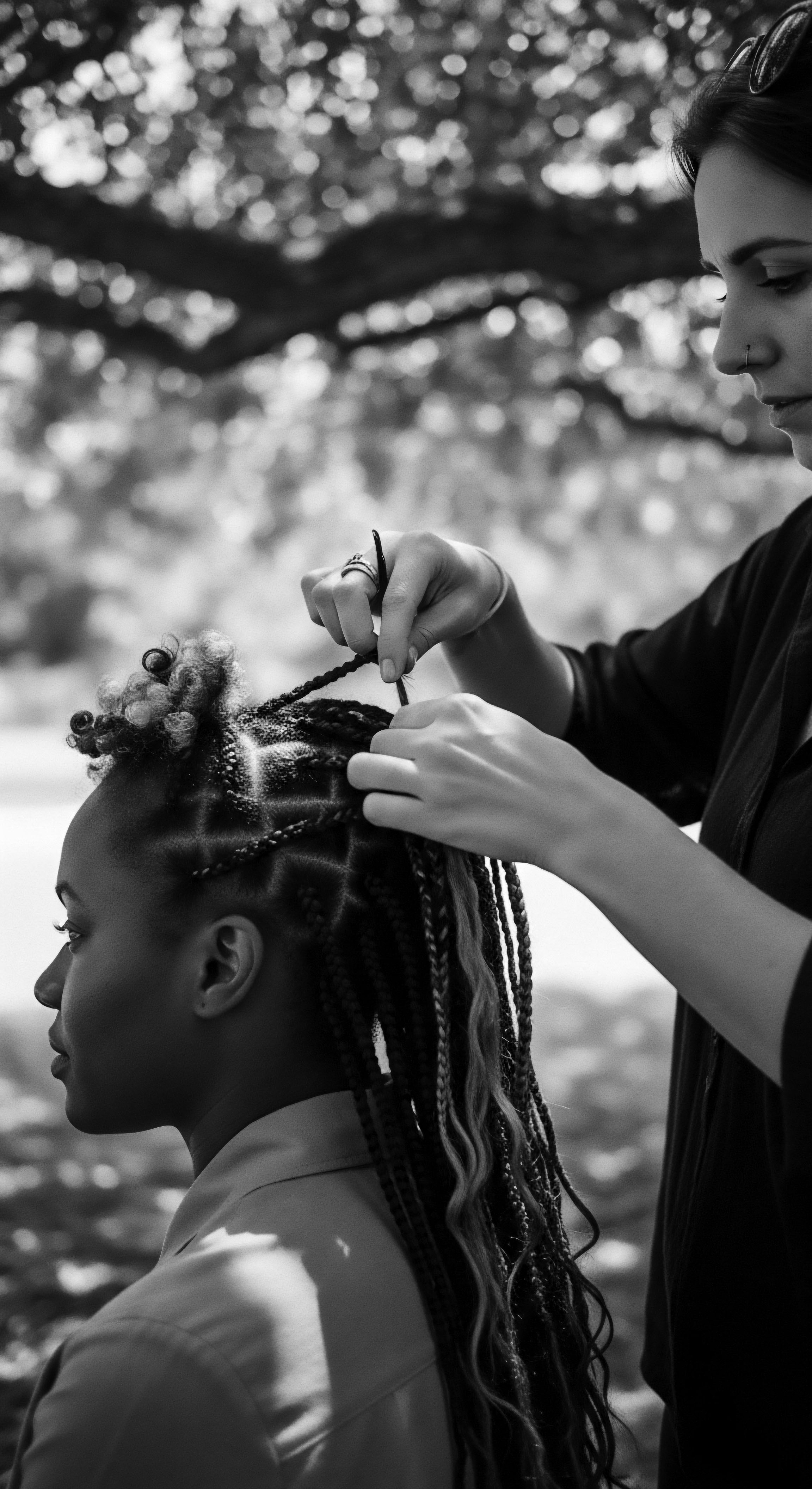
Reflection on the Heritage of Natural Hair Protections
As we close this thoughtful exploration of Natural Hair Protections, we recognize that the journey from elemental biology to the unbound helix of identity is not merely an intellectual pursuit. It is a profound meditation on the enduring spirit of textured hair and the communities that carry its stories. The whispers of ancestral wisdom, carried on the gentle breeze of time, echo in every strand, reminding us that care for our hair is care for our lineage, for our heritage, and for our very being. It is a sacred trust, passed down through the ages.
The definition we have woven together is a testament to the fact that ‘protection’ for textured hair is a holistic endeavor. It honors the ingenuity of those who first understood the language of the strands, who discerned the secrets of the earth’s bounty to nourish and shield. It celebrates the profound resilience exhibited through trials, the steadfast refusal to abandon the inherent beauty and truth of one’s hair in the face of pressures to conform. Every protective style, every oiling ritual, every communal gathering around hair, has served as a gentle yet firm assertion of selfhood, a quiet reclamation of power.
Today, as new generations rediscover and reclaim their natural textures, they are not simply adopting a trend. They are stepping into a profound legacy, reconnecting with practices that have sustained and uplifted their ancestors. The scientific insights of our time, when layered upon this deep well of ancestral knowledge, do not diminish the wisdom of the past.
Instead, they illuminate it, providing new understanding of how and why these time-honored methods have always been effective. This ongoing conversation between ancient wisdom and contemporary understanding enriches our appreciation for the protective qualities inherent in textured hair and the enduring traditions that honor it.
The Natural Hair Protections, then, stand as a living, breathing archive, a testament to the profound connection between hair, heritage, and the soul. It is a continuous narrative of care, creativity, and steadfast identity, inviting each individual to find their place within this sacred story, to listen to the echoes from the source, to feel the tender thread of connection, and to celebrate the vibrant, unbound helix that is their unique crowning glory. This journey reminds us that in nurturing our hair, we also nurture our roots, our history, and the boundless potential of our future.
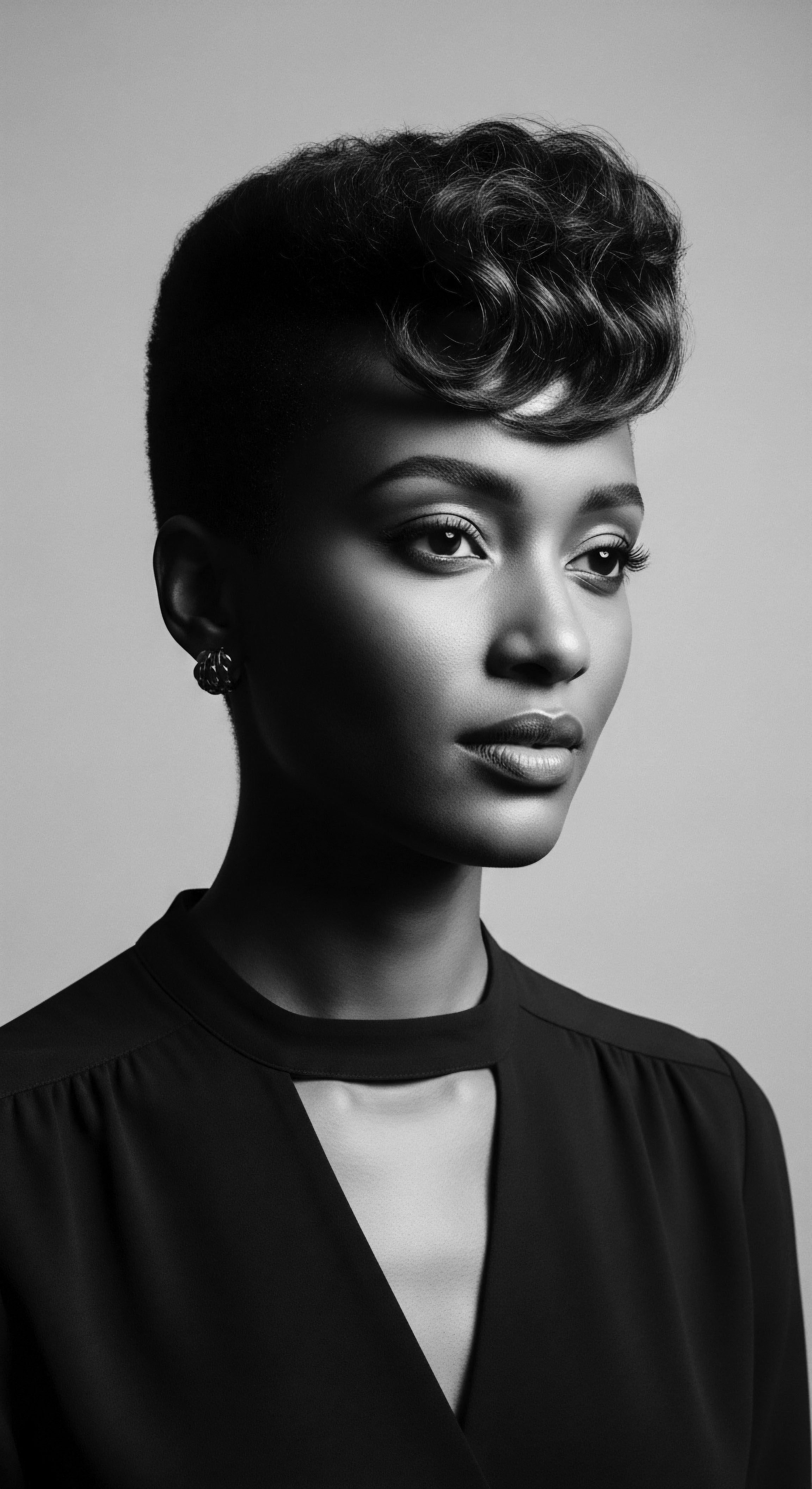
References
- Byrd, A. D. & Tharps, L. D. (2001). Hair Story ❉ Untangling the Roots of Black Hair in America. St. Martin’s Press.
- Opoku, A. (2018). The Cultural and Spiritual Significance of African Hairstyles. University of Ghana Press.
- Banks, I. (2017). Hair Matters ❉ Beauty, Power, and the Politics of Dreadlocks. New York University Press.
- Ross, B. (2009). Black Hair ❉ A Cultural History. Dover Publications.
- Walker, A. (2012). The Natural Hair Handbook ❉ The Definitive Guide to Natural Hair. HarperCollins Publishers.
- Akbar, A. (2019). Ancestral Healing ❉ The Art of Hair and Self-Care. W. W. Norton & Company.
- Cousins, L. (2005). Hair in African Art and Culture. The Museum for African Art.
- Robinson, N. J. (2021). The Science of Black Hair ❉ A Comprehensive Guide to Textured Hair. Naptural Roots Publishing.
